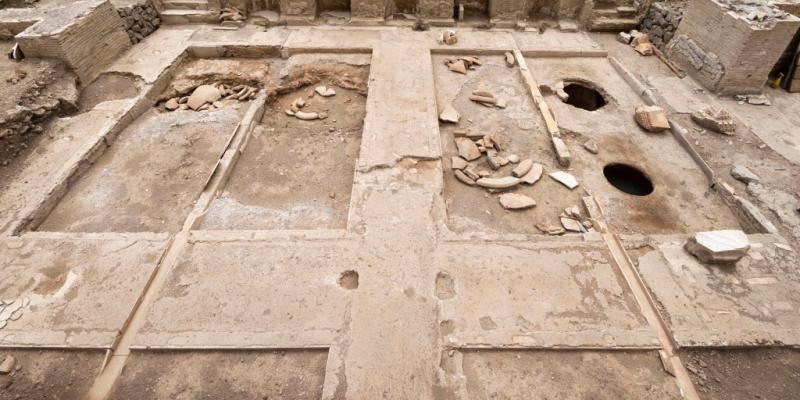Lavish ancient Roman winery discovered at Villa of the Quintilli
Category: News & Politics
Via: perrie-halpern • last year • 10 commentsBy: Patrick Smith (NBC News)



While citizens filled the Colosseum for gladiator duels, ancient Roman aristocrats took trips to a lavish facility to celebrate a very different theatrical spectacle: winemaking.
The Roman elite gathered annually to watch wine being made at a purpose-built facility complete with marble-lined areas for treading grapes and gushing fountains of wine, according to new findings that shed light on their luxurious lifestyle.
The winery was found in excavated ruins at the vast Villa of the Quintilii, south of Rome and next to the ancient Appian Way road. It is only the second known example in the Greco-Roman world of a site built specifically to view the theater of winemaking.
According to a new analysis released Monday, the complex was built or expanded around 240 A.D. to allow the very elite of the Roman world — possibly including emperors — to view the traditional production process, such was the importance of wine and agriculture to the nobility's wealth and power.
 Left: A staircase leading up to the treading and press area, with marble facing still intact. Right: A wine cellar with iron rims reinstated in their original positions.E. Dodd
Left: A staircase leading up to the treading and press area, with marble facing still intact. Right: A wine cellar with iron rims reinstated in their original positions.E. Dodd
Emlyn Dodd, an academic at the British School in Rome and an expert in ancient wine and oil markets, detailed the ritualistic winemaking at the site in the academic journal Antiquity.
"Wine was a huge source of wealth for the Roman elite. They owned vast amounts of land dedicated to viniculture, winemaking, and they were selling it all across the Mediterranean," Dodd told NBC News.
"But at the same time, wine permeates the whole culture and society — it's used in religion, medicine, in daily life. It was the main beverage when water wasn't safe to drink."
The villa, which at its height was a mini-city spanning 24 hectares (almost 60 acres), was most likely built by the Quintilii brothers, who served as consuls of Rome in 151 A.D. They were killed by Emperor Commodus in around 181 A.D., who then seized their properties.
Emperor Gordian III — who became sole emperor in 238 at just age 13 before he was killed six years later — owned and expanded the winery, and while it's not known whether he attended, he did live in Rome for four years while it was active.
The level of decoration and comfort was "comparable to the sort of place the emperor would have been living in and staying in," Dodd said, adding that the site was definitely not a villa rustica, or a regular working farm.
Whoever was lucky enough to get invited to the winery at Quintilii would have seen men treading grapes with their bare feet in a rectangular area measuring 37 feet by 14 feet.
Whereas most Roman grape treading areas are lined with cocciopesto, a type of waterproof concrete, this one was partly completed with red marble, a sign of wealth and opulence. Marble gets very slippery when wet — ropes were installed for the treaders to grip — signaling that luxury took precedence over workplace safety.
 A section of paving found in the excavated western dining room. Archaeologists think lavish dinners were held here, possibly hosting emperors.Stefano Castellani / Dodd, Galli, Frontoni 2023
A section of paving found in the excavated western dining room. Archaeologists think lavish dinners were held here, possibly hosting emperors.Stefano Castellani / Dodd, Galli, Frontoni 2023
The crushed grapes then went to two mechanical presses before the resulting brightly colored liquid flowed into niches, creating a fountain-like effect across a facade made from white, gray and red marble strips.
Dining rooms, some of which are still to be excavated, were lavishly decorated with marble motifs, and they allowed guests to view each stage of the winemaking process through wide entrances.
"With the addition of various sounds — workmen joking, laughing or grunting, and the music that accompanied treading — a truly theatrical impression would have been realised," Dodd and colleagues wrote in the Antiquity article.
The theatrical nature of the process is underlined by the Rome region's being absent from Roman writers' discussion of the greatest winemaking areas.
"About an hour's drive south of Rome there are some very famous terroirs for ancient Roman wine, which are mentioned over and over again and which we know produced very expensive wine," Dodd said.
"It's much more about the spectacle than the product being produced. The level of decoration, with these fountains of wine, really shows that."
Another winery, at Villa Magna, 30 miles to the southeast, was visited by the future Emperor Marcus Aurelius, and it is the only other known site made for the symbolic, theatrical production of wine.
Such merriment may have been a welcome distraction for Rome's political-military elites in the mid-third century as they repelled attacks from barbarian tribes to the north of the Italian peninsula and waged war against the Persian empire for control of Syria.
Wine had been made and traded for centuries before the Roman Empire, and it can be traced back to the Greeks and the Etruscans. But it was Rome that promoted the everyday availability of wine across society while exporting winemaking to far-flung reaches of the empire.

Tags
Who is online
453 visitors

Who would have guessed, Romans and wine.
People still travel to wineries to celebrate wine making. There's a train trip through Arkansas leaving out of Van Buren, I think, that takes people through the wine country and it makes stops for tasting. I want to do that!
yeah, the goober wine region is world renowned...
instead of foil, they put little white cotton hoods over the bottle tops...
Oh, c'mon! It's not bad for wine
LOL, 2ez
you just bite me
Arkansas, you're sure you're not mixing up wine with moonshine?
I got nothing
Great article.
Ancient Romans did really know how to party!